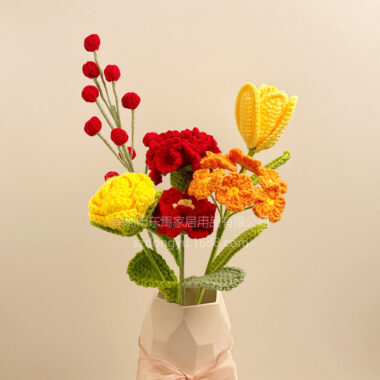🌸 Introduction
Artificial flowers have evolved far beyond simple plastic decorations. Today, they are sophisticated products crafted with precision, artistry, and technology. Buyers worldwide—from wedding planners to retailers—depend on artificial flower factories to deliver lifelike designs that meet strict quality standards. Yet many global customers know little about what happens inside these factories.
Understanding how a factory operates can give buyers confidence in product quality and supply reliability. From selecting raw fabrics to carrying out final QC, every stage plays a vital role in shaping the final bouquet. This article takes you inside the artificial flower factory, offering insights from materials to packaging.
🧵 1. Selecting the Right Materials
The journey begins with raw materials. A reliable artificial flower manufacturer sources fabrics that balance realism, cost, and durability. Silk and polyester remain popular choices due to their flexibility and natural finish. PU (polyurethane) is often used for petals and leaves that require extra softness. Increasingly, eco-friendly fabrics are being introduced to meet sustainability goals.
Material selection is critical because it determines the texture, color retention, and overall appearance of the flower. Top factories inspect each fabric roll for defects, thickness, and consistency before production begins. This step ensures that every artificial flower has a strong foundation of quality.
⚙️ 2. Machinery and Production Lines
Once materials are approved, the factory floor comes alive with machinery. Specialized molding and injection machines create petal and leaf bases. Coloring lines apply gradients and patterns to mimic the variations of real flowers. Advanced printing techniques can even replicate veins and natural imperfections.
However, machines are only part of the process. Skilled workers assemble petals, shape stems, and attach leaves by hand. This combination of automation and craftsmanship allows factories to scale production while maintaining lifelike detail. The balance of efficiency and artistry is what makes high-quality artificial flowers stand out.
🎨 3. Customization in the Factory Process
One of the greatest advantages of working with a professional artificial flower supplier is the ability to customize. Buyers often request unique Pantone colors, specific stem lengths, or branded packaging.
Factories can adjust molds, dyes, and printing techniques to achieve these goals. For example, a wedding event planner may need pastel-colored roses, while a retail chain may request bold hydrangeas in mixed assortments. Customization adds value for buyers by turning a generic flower into a branded product tailored to specific markets.
📦 4. Quality Control at Every Stage
A serious artificial flower factory never leaves quality to chance. QC begins with raw material checks and continues through every production step. During molding, technicians verify that petals are consistent in thickness and shape. In coloring, inspectors check gradients to ensure even coverage.
Before packaging, each finished flower undergoes a final QC review. Defective items are removed, and only products that meet strict standards move forward. Many factories also maintain sample rooms, allowing buyers to view collections and test designs before placing wholesale orders. This transparency builds trust between manufacturers and global buyers.
🚢 5. Wholesale Readiness and Export Packing
Artificial flowers are fragile, so secure packaging is essential. Factories prepare wholesale cartons that can hold mixed SKUs while preventing damage. Bubble wrap, separators, and reinforced cartons protect delicate petals during long journeys.
Export readiness goes beyond packaging. Documentation such as invoices, packing lists, and certificates of origin are prepared to streamline customs clearance. A reliable factory partner ensures not only product quality but also a smooth delivery process, giving international buyers peace of mind.
🤝 6. The Buyer–Factory Partnership
For global buyers, understanding factory operations is more than curiosity—it’s a tool for building stronger partnerships. When you know how materials are sourced, how QC is handled, and how logistics are managed, you can ask the right questions and set realistic expectations.
Working directly with a factory instead of intermediaries often results in better pricing and more flexible customization. It also establishes a long-term relationship built on trust, transparency, and shared growth. A good artificial flower manufacturer acts as a partner, not just a vendor.
🌺 Conclusion
The making of an artificial flower is a complex journey that blends raw materials, technology, craftsmanship, and strict quality checks. From the first fabric roll to the final QC inspection, each step ensures that the flowers reaching global buyers are realistic, durable, and market-ready.
For brands and retailers, knowing how an artificial flower factory operates brings confidence when choosing a supplier. By working with a trusted manufacturer that offers customization, wholesale flexibility, and reliable export support, global buyers can secure both quality products and long-term business success.
Artificial flowers are more than just decorations—they are the result of expertise, dedication, and collaboration between factories and buyers worldwide.








